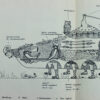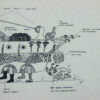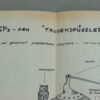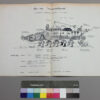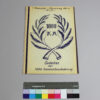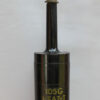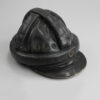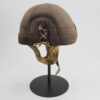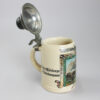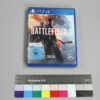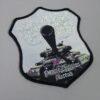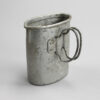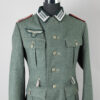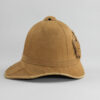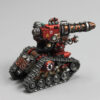Caricature SPz-new (marten), late 1960s
Inventory number: DPM 6.2128
The Bundeswehr was equipped with equipment from allied armies such as the US Army’s M39 infantry fighting vehicle and the French Army’s Hotchkiss. In the 1960s, Germany then began to implement its own armaments projects. In addition to the Standard main battle tank, the Bundeswehr was also to receive a German infantry fighting vehicle. While the Wehrmacht still used lightly armed armored personnel carriers with an open top, the Bundeswehr’s armoured infantry were to be brought into battle and supported by a better protected and armed vehicle.
Due to the disastrous progress of the HS 30 project, the development of a new infantry fighting vehicle was already considered necessary during its production. The shortcomings of the HS 30 also defined many of the requirements for the “new SPz”: Better mobility to keep up with the Leopard in the field, protected dismounting and remounting of the grenadiers thanks to a tailgate and a modern machine gun. In view of the enemy’s BMP-1 infantry fighting vehicle, the cannon had to be powerful enough to break its armor and the vehicle had to have sufficient protection against armor-piercing ammunition. Due to the nuclear threat during the Cold War, NBC protection for the fighting compartment was also considered necessary. However, the program did not aim to develop a single model, but a family of vehicles. According to the military requirements in 1960, ambulances, anti-aircraft tanks, scout tanks, armored personnel carriers and many other variants were also to be produced based on the infantry fighting vehicle. The family was to be standardized and have as many similar assemblies as possible.
The contract for the development was awarded to the Rheinstahl Group and Henschel AG with the Swiss company Mowag. Both industrial groups included companies that had already built tanks under National Socialism. Technically, however, the new design of the armored personnel carrier was a challenge, as a new concept had to be found in order to meet the military requirements. In addition, these were adapted several times, which is why the companies built a total of 28 prototypes and ten pre-series vehicles in three generations.
As a result, the development was more expensive than planned and took considerably longer than planned at eleven years. In 1970, the “new infantry fighting vehicle” was given the name “Marder” and in 1971, the Bundeswehr armored infantry received the first of around 2,000 series vehicles ordered from Rheinstahl AG Kassel and Atlas-MaK Maschinenbau GmbH in Kiel.
This caricature of the marten was created “from many serious and also amusing conversations” at Rheinstahl-Henschel in Kassel at the end of the 1960s. After the modification conferences with the Federal Office of Defense Technology and Procurement, an employee began working on this drawing, which was continuously supplemented by various employees after each meeting. The drawing was eventually copied several times, which was still a fairly new technology at the time. The company had an analog copier for its technical drawings. The copies of the caricature were given to numerous employees at Rheinstahl-Henschel to commemorate the project. The owner of this “millipede” was involved in the management of the Marder’s construction.
At the end of the Marder project, a vehicle was created with which the troops were satisfied. Furthermore, the Marder chassis was ultimately only used for the Roland anti-aircraft missile system; the other planned variants were not realized. Instead, the much more cost-effective US M113 was used as the basis. In retrospect, the Standard main battle tank and SPz neu projects not only marked the beginning of the reconstruction of the German tank industry, but also the first structures for cooperation between the procurement office, the armed forces and the armaments industry.
Object of the month
(short) stories from the depot
Unfortunately, many objects cannot currently be shown in the exhibition for conservation reasons. Here you will find unusual objects and exciting stories of special pieces from the depot


